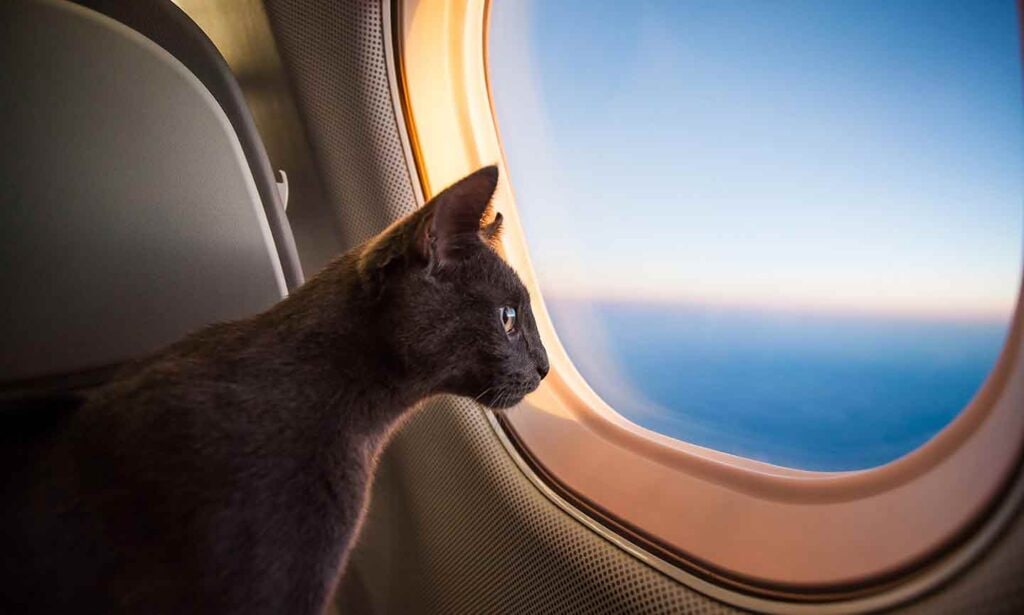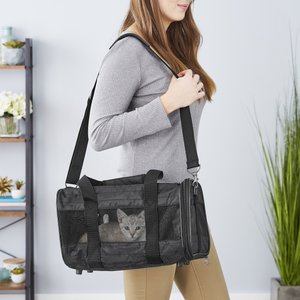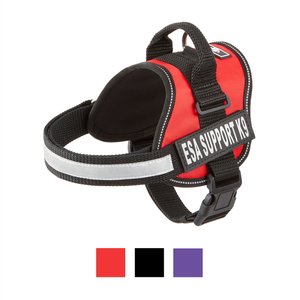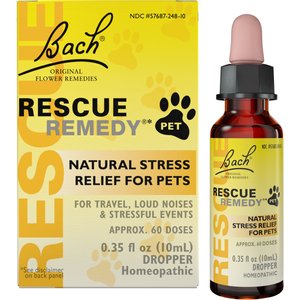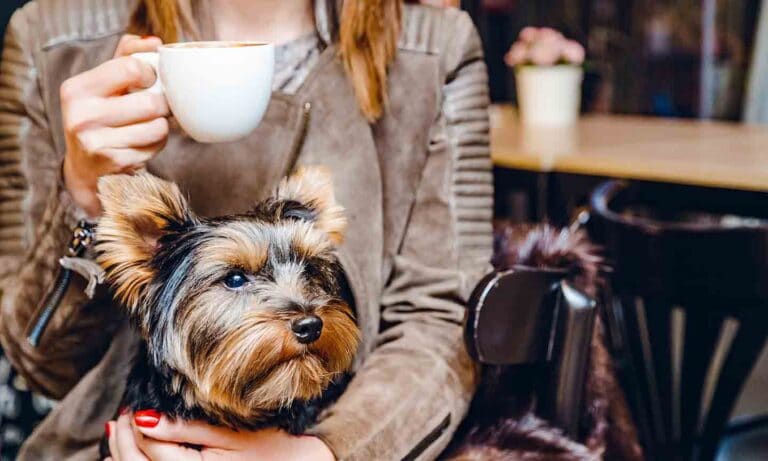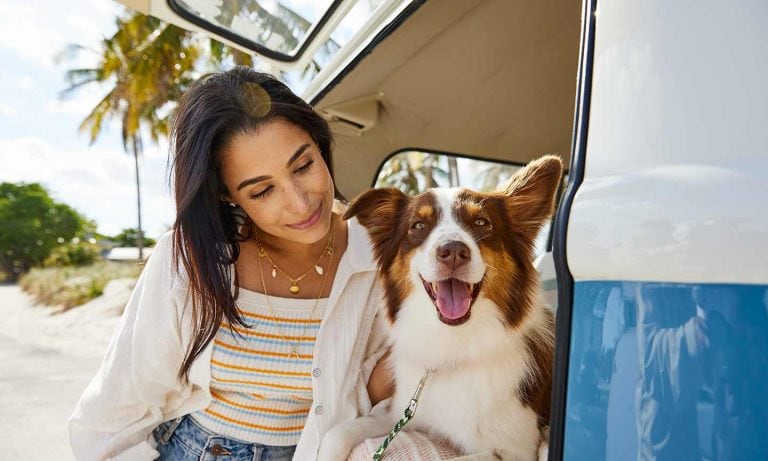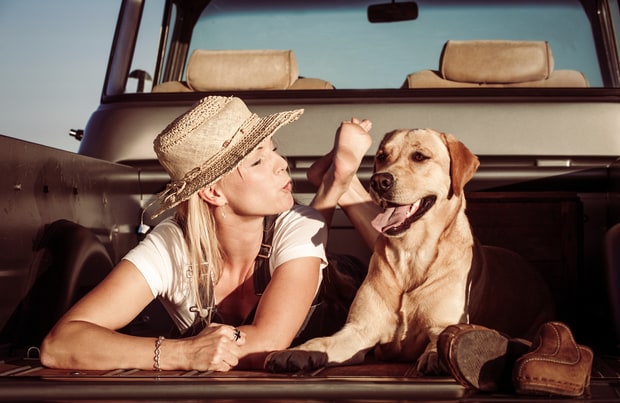Gone are the days of leaving your pet at home while you travel. Now, you can (thankfully!) bring Fido or Fluffy along just about anywhere, whether by plane, train or automobile. If you have a serious case of wanderlust, and want to fly to see the sights and explore new places with your beloved pet, preparation is key—plane and simple.
Below, we dive into several factors to consider before booking a flight with your little adventurer.
In This Guide
Pet-Friendly Airlines
First things first: finding an airline that’ll welcome your BFF! Because not every airline policy is the same, it’s important to find one that accepts your pet based on their size, weight and breed. Although emotional support animals are now considered pets on flights, airlines have individual policies for service animals than they do for pets.
While every airline will have different requirements for a pet carrier’s maximum dimensions, it’s typical that it must fit underneath the seat in front of you.
Alaska Airlines
$100 each way per carrier for pets traveling in the passenger cabin; $150 each way for pets traveling in the baggage compartment
Dogs, cats, rabbits and household birds can fly in the main cabin. Cats and dogs must be at least eight weeks old and vaccinated. All pets must stay within their carrier at all times. Pet parents can travel with up to two pet carriers max. For pets traveling via baggage compartment, they must be at least eight weeks old and have a health certificate. The pet and carrier can weigh a maximum of 150 pounds combined. Brachycephalic breeds aren’t accepted.
Allegiant Air
$50 each way
Pet parents may have only one pet carrier with no more than two pets in it. Dogs and cats are accepted to fly in-cabin. Pets must be at least two months old; health certificates aren’t required. Pets aren’t permitted to fly in the cargo bin.
American Airlines
$125 one-way for carry-on pets; varies for cargo pets; $200 one-way per kennel for checked pets for active-duty U.S. military and state department personnel
The combined weight of a pet and carrier in-cabin must be no more than 20 pounds. Pets traveling in the cabin count as a single carry-on bag. (You may still bring a personal item.) Dogs must be at least two months old to travel. A pet who doesn’t fit in a carrier under the seat in front of you must travel with cargo. Checked pets are only accepted for active-duty U.S. military and state department personnel at the ticket counter. Pets traveling via American Embark can weigh up to 100 pounds, including the weight of the carrier. American Airlines doesn’t accept brachycephalic breeds of cats or dogs as checked pets.
Delta Air Lines
$95 each way
Pets must be at least 10 weeks old for domestic travel and 16 weeks old for international travel. Only one pet is allowed per kennel, with the exception of one female cat or dog traveling with an unweaned litter—or if two pets of the same breed and size are between 10 weeks and six months old and can both comfortably fit. A pet in a carrier counts as a carry-on item. For pets traveling via cargo, health certificates are required. Brachycephalic cats and dogs cannot fly in cargo.
Frontier Airlines
$99 per pet, one way
Pets including dogs, cats, rabbits, guinea pigs, hamsters and small household birds must be at least eight weeks old. These pets are allowed to travel in-cabin on all domestic flights; only dogs and cats may travel internationally. Frontier doesn’t allow pets to be checked as baggage.
Hawaiian Airlines
$35 one-way if traveling within the state of Hawaii; $125 one-way if traveling between Hawaii and North America
Hawaiian Airlines accepts only dogs and cats in the passenger cabin. Your pet and carrier can weigh up to 25 pounds. Cats, dogs and household birds may travel as checked baggage. The combined weight of your pet and carrier can be up to 70 pounds.
JetBlue
$125 each way
Only small dogs and cats are accepted in the cabin; the carrier and pet combined must weigh no more than 20 pounts. A maximum of two pets per guest is permitted with each pet in their own carrier. JetBlue doesn’t book pets in cargo.
Southwest Airlines
$125 each way per pet carrier for the U.S. mainland; $35 each way per pet carrier between Hawaiian islands
With Southwest Airlines, pets must be cats or dogs who are at least eight weeks old and vaccinated. Pet parents can have one carrier that holds two pets of the same species. Pets are allowed on flights between Hawaiian islands but not to or from Hawaii, as well as internationally. Pets cannot travel in cargo.
Spirit Airlines
$125 per pet container, each way
Only dogs, cats, small household birds and small domestic rabbits can travel with Spirit. Pet parents are allowed only one soft container. Pets must be at least two months old; health certificates aren’t required unless you’re traveling to the U.S. Virgin Islands. Pets are unable to travel on international flights unless they’re service dogs. Cargo transportation isn’t permitted.
United Airlines
$125 one-way pet fee; an additional $125 fee for each layover of more than four hours in the United States and more than 24 hours internationally
All pets—with the exception of service animals—must be in a carrier that fits under the seat in front of you. Pets traveling on domestic flights must be at least two months old. If traveling internationally, they must be at least four months old.
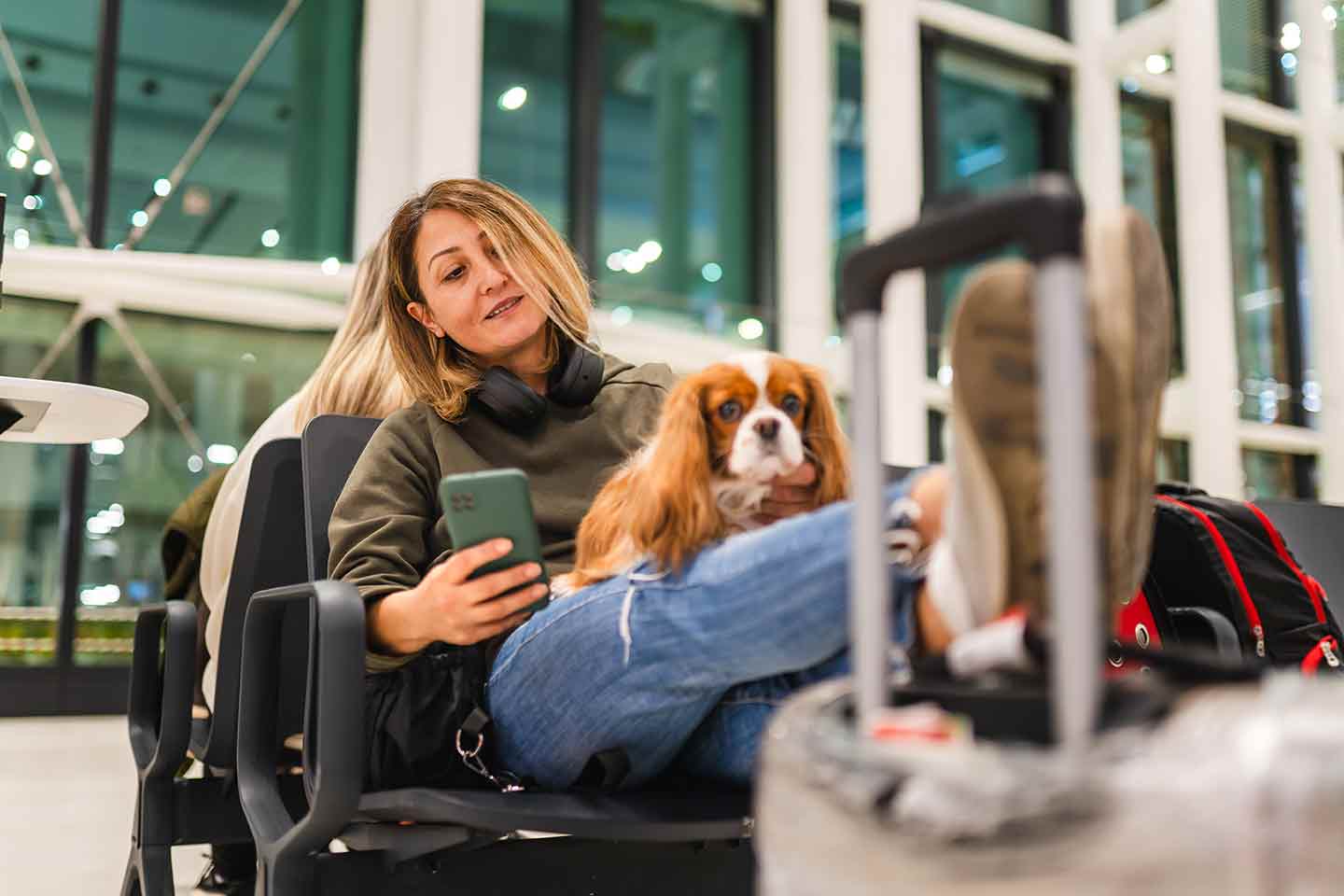
Should You Be Flying With a Dog or Cat?
Before you decide to fly with your pet, it’s in their best interest to consider whether they’re medically fit and prepared for air travel.
Dr. Nelva J. Bryant, an airline industry veterinarian and pet-centric travel expert, CEO and founder of pet travel consultation service When Pets Fly in Atlanta, recommends consulting with your veterinarian as early as possible when you know your travel plans. You and your vet will review your pets’ medical records to see if they meet the requirements for air travel and if it’s the best option for them.
“If a pet has an underlying or pre-existing medical condition, such as heart disease, respiratory disease, diabetes, anxiety, etc., it is not recommended for the pet to travel via air,” Bryant says.
She shares a few examples of pets with certain conditions who should avoid flying:
If a pet is overweight, they’re prone to overheating. This could lead to heat stroke.
With advanced age, some pets develop underlying medical conditions that could become exacerbated during air travel.
Pregnant dogs or cats shouldn’t be transported during the third trimester, as the stress of travel could lead to premature labor or put their babies’ lives at risk.
What’s more, pets who have anxiety, such as separation anxiety or noise aversion, may find traveling to be extremely unpleasant and stressful.
“During air travel, dogs and cats are exposed to an unfamiliar environment with new people, unusual sounds and smells, and varying temperatures and lighting,” Bryant says. “These stressors are unpredictable and can have a compounding impact on dogs and cats. However, the impact on a dog or cat can vary from one extreme to the other.”
While many dogs and cats appear relaxed during air travel, Bryant says others may exhibit clinical signs of stress, such as:
- Drooling
- Licking lips
- Panting
- Shaking
- Whining
- Excessive barking
- Trying to break out of their travel crate (in extreme cases)
If your pet has anxiety but must travel via plane, Bryant recommends finding ways to calm them, such as with calming music when getting them acclimated to confinement in their crate or carrier, giving calming pet treats, or using pheromones (e.g. Adaptil for dogs; Feliway for cats).
She advises never to use prescribed anti-anxiety medication that causes sedation during air travel. Not only is it against airline pet travel policies, but it can also be dangerous to your pet’s health.
Another factor to keep in mind before flying with your pet is whether they’re a brachycephalic breed. These types of dogs (e.g. French Bulldog, Boxer, Pug) and cats (e.g. Burmese, Persian, Himalayan) have short noses and flat faces that ultimately affect their ability to breathe and regulate their body temperature.
Because of this, Bryant says they’re prone to developing heat stroke when stressed and may develop complications during travel, even in the cabin. Most airlines also prohibit transport via cargo hold for these breeds.
If you decide to fly with your brachycephalic breed, Bryant recommends:
- Making sure the crate is one size larger than the standard size for your pet.
- The extra space and airflow are needed for them to be comfortable during the flight.
- Not putting clothing on your pet if they’re traveling in their crate, as it can make them overheat.
- Traveling with your pet during the coolest times of the day or during the coolest seasons to prevent exposure to heat and humidity.
Things to Consider Before Booking
Flying with your cat or dog takes significant planning to make sure they’re safe and comfortable every step of the way.
Bringing your pet with you in-cabin is the safest and least stressful way for your pet to fly. When you keep your pet by your side, you can check on them to ensure they’re safe and comfortable, and having a trusted pet parent close by can be calming for many pets. Pets shipped in a plane’s cargo hold, on the other hand, may be exposed to noisy conditions and extreme temperatures, with no one checking on their safety or offering a soothing presence. Plus, carrying your pet on the plane yourself eliminates the risk of the airline misplacing your pet. Overall, in-cabin travel is better for your pet’s physical and mental well-being, as well as their safety.
If your pet is traveling with you in-cabin:
- Getting a ride to the airport is ideal if you want to avoid airport parking fees, but some taxi/rideshare services may not accept pets. Be prepared to drive yourself if needed.
- Your pet can use pet relief areas at the airport, but will have to hold it on the plane until you get to your destination. Be sure they’ve had a chance to relieve themselves before boarding.
If you’re not able to travel with your pet in-cabin, consider these preparation tips from Marck Maroun, operational manager at Feathers and Fur Express, an international pet shipping company in Conley, Georgia.
If your pet is traveling in a crate as a checked bag or cargo:
- Just as with your pet traveling with you in-cabin, you may need to drive yourself if pet-friendly taxi or rideshare services aren’t available.
- Make sure your pet is walked and exercised because they won’t have an option for relief once checked in. At the check-in, the crate is usually sealed and won’t open until the layover or arrival at your destination. Most airlines require your pet to be at the airport 4–6 hours prior to departure. Expect your pet to be in the crate for 12 hours of longer, depending on the duration of flight. (That lengthy crating period is another reason vets advise against pets in cargo.) If you’re traveling internationally, keep in mind that it usually takes 2–4 hours to clear customs, adding to the amount of time your pet will be in the crate.
- Maroun says most pets are anxious and nervous throughout the process, and tend not to eat as much. (There are also some who may sleep through all of it, but this is less common.)
- Pets should have ample water available, as the guidelines state there must be water in their bowls at check-in.
Another option: hiring a pet transportation company. These services help with the logistics of flying a pet from one place to another by picking your pet up, checking them into cargo, clearing them through customs if necessary, and delivering them to you at your final destination. Keep in mind, however, that this option still places your pet in a loud, unsupervised cargo hold where temperatures can become very hot or very cold. It’s always best to bring your pet with you in-cabin if possible.
If you’re hiring a pet transportation company:
- You’ll have the option to have your pet picked up from your residence and delivered to the airport for check-in. If you opt out of the pickup, you’ll be provided with a time and address to meet up with your check-in agent.
- They’ll clear your pet through customs and relieve them as soon as they are able, which is right after they clear customs. Then, they’ll deliver them to your house, stopping for breaks depending on the drive time.
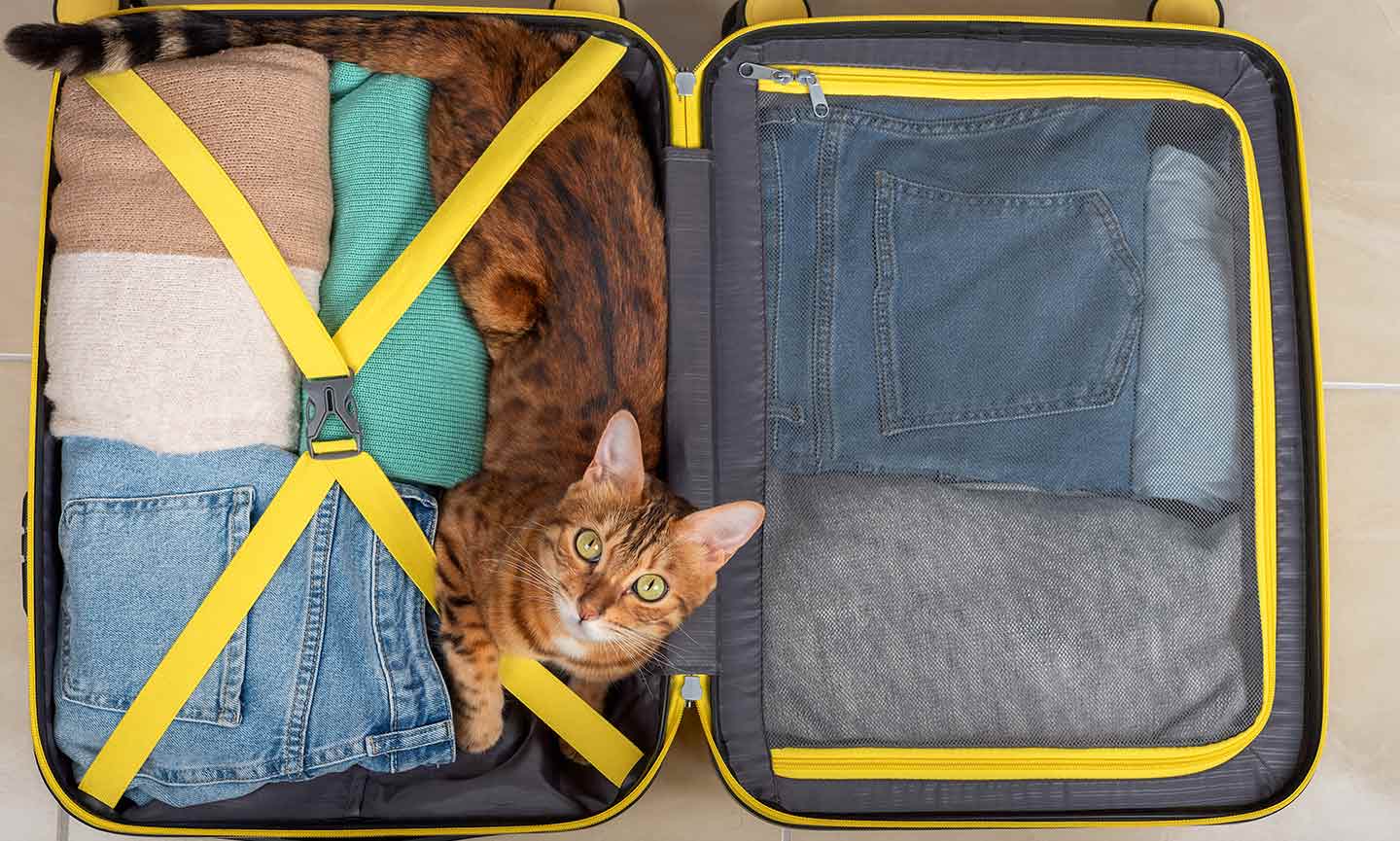
How to Prepare for Your Flight
Give yourself more than enough time to get ready for your flight with your furry friend. Every bit of preparation can be helpful, especially in the event that things don’t go as planned.
Maroun shares the following tips on how to prepare:
- Regardless of whether it’s interstate or international travel, make sure your pet has the correct state- or country-specific health documents needed to enter the destination. This is a rigid rule, and without them, your pet won’t be able to fly. Check with your airline to find out which documents you need.
- Check the USDA’s pet travel page for alerts or information on imports, exports or interstate travel. Every state and country has its own regulations. This is where you can find nearly all the information you need, especially if you’re shipping your pet to another country.
- Try to book your flight on a Wednesday or Thursday. Weekend arrivals and departures tend to have staff shortages. When trying to mitigate an issue on a weekend or even in a different country, people tend to not respond quickly on weekends. It’s best to avoid weekend travel if possible.
- Always have a backup plan in case the airline rejects your pet. A friend or family member waiting outside is a great asset.
Bryant adds that you’ll also need to find a crate in which your pet can stand; sit upright without touching the top of the crate; and lie down comfortably. For pets traveling via cargo, find a crate that’s compliant with the International Air Transport Association (IATA) requirements. She recommends getting your pet acclimated to confinement in their travel crate or carrier. The process can take weeks to months, but will help them see it as a haven and make travel more comfortable for them. Get tips on how to crate train a dog.
Departure Day Tips
The thought of departure day can be stressful, but it doesn’t have to be.
To prepare for your and your pet’s big day, Maroun shares the following tips:
- Avoid overfeeding your pet on the travel date. A small snack 4–5 hours prior to departure should be sufficient.
- Walk or exercise your pet a lot. This will help tire them out so they can rest and (hopefully) not feel too anxious.
- Be polite to the airline representative. While airline representatives can’t overlook faulty documents, they can extend the check-in time and allow some comfort items like toys in the crate. Being kind will always work in your favor.
- Know your drop-off time and location. Double check traffic and give yourself at least two extra hours to avoid unforeseen changes.
Do You Need Health Certificates When Flying With Pets?
A pet health certificate, also known as a Certificate of Veterinary Inspection, is a document that is essentially a form of identification for your furry friend that states they’re free of infectious diseases of both pets and people. To obtain one, a USDA-accredited vet will examine your pet to confirm that they meet the state or country’s health requirements.
A health certificate contains the following information:
- The pet parent’s or shipper’s contact info (e.g. name, address, emergency contact phone number)
- The pet parent’s or person receiving the pet’s contact info
- The pet’s official animal ID (e.g. microchip number or tattoo number)
- A description of the pet (e.g., name, age, gender, breed, coloration, markings
and weight) - The destination state’s required vaccinations and/or diagnostic test results
- A certification statement
- The USDA-accredited vet’s signature
While most airlines require a health certificate, whether your pet needs one ultimately depends on the airline and the state you’re traveling to within the United States. However, all pets are required to have health certificates when traveling internationally, Maroun says.
Entry requirements for pets vary from state to state and country to country. The USDA’s pet travel website is the best place to gather information. It’s always a good idea to talk to your vet for additional guidance, too.
Best Airline Pet Carriers
Your cat or dog will be spending the duration of the flight in a pet carrier—so they’ll need one that checks all the boxes for being airline-approved, comfy and safe.
When traveling with your pet in-cabin, Bryant says your pet’s travel carrier must be:
- Within the airline’s requirements. Some airlines have size restrictions on pet carriers, and others have weight restrictions. Contact your airline to learn more about their pet in-cabin policies.
- Appropriately sized for your pet. Your cat or dog should have ample space to stand, turn, sit up and lie in a natural position while in their carrier.
- Well-ventilated. Ventilation openings must be at least 16 percent of the total surface of the four sides of the container.
- Escape-proof. Your pet’s travel carrier must be constructed of materials to ensure they’re comfortably inside the carrier during air travel with no ability to escape.
- Leak-proof. A travel carrier with a solid, leak-proof floor or absorbent bedding can help capture any urine.
Tips for Traveling With Pets Internationally
Surely, traveling around the world with your four-legged friend requires more planning compared to domestic travel, but it’ll be oh-so worth the experience!
Maroun recommends the following tips for overseas travel with your pet, including:
- Putting your name and contact info on your pet’s crate or carrier
- Having a domestic phone number so you can make and receive calls in the event your pet is lost
- Renting a vehicle large enough to accommodate their crate or carrier
- Having local currency in the event you need to pay for something quickly
- Adding a GPS tag on your pet’s crate or carrier
Flying with a pet requires planning, from consulting a vet on whether they should be flying and deciding which airline to use, to finding the perfect pet carrier and preparing for your departure day. But your pet—and you!—will be happy you took the time to optimize your traveling experience. Between delays and cancellations, it’s always best to take the unexpected into consideration. Once you’ve reached your destination, you’ll be ready to make fun, new memories with your best furry friend!
Need more tips on how to make traveling better for you and your pet? We’ve got you covered.
Expert input for this story provided by Dr. Nelva J. Bryant, an airline industry veterinarian and pet-centric travel expert, and CEO and founder of When Pets Fly in Atlanta; and Marck Maroun, operational manager at Feathers and Fur Express, an international pet shipping company in Conley, Georgia.
More Pet Travel Tips
Share:
